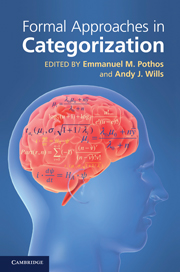Book contents
- Frontmatter
- Contents
- List of figures
- List of tables
- List of contributors
- 1 Introduction
- 2 The generalized context model: an exemplar model of classification
- 3 Prototype models of categorization: basic formulation, predictions, and limitations
- 4 COVIS
- 5 Semantics without categorization
- 6 Models of attentional learning
- 7 An elemental model of associative learning and memory
- 8 Nonparametric Bayesian models of categorization
- 9 The simplicity model of unsupervised categorization
- 10 Adaptive clustering models of categorization
- 11 Cobweb Models of Categorization and Probabilistic Concept Formation
- 12 The knowledge and resonance (KRES) model of category learning
- 13 The contribution (and drawbacks) of models to the study of concepts
- 14 Formal models of categorization: insights from cognitive neuroscience
- 15 Comments on models and categorization theories: the razor's edge
- Index
- References
3 - Prototype models of categorization: basic formulation, predictions, and limitations
Published online by Cambridge University Press: 05 June 2012
- Frontmatter
- Contents
- List of figures
- List of tables
- List of contributors
- 1 Introduction
- 2 The generalized context model: an exemplar model of classification
- 3 Prototype models of categorization: basic formulation, predictions, and limitations
- 4 COVIS
- 5 Semantics without categorization
- 6 Models of attentional learning
- 7 An elemental model of associative learning and memory
- 8 Nonparametric Bayesian models of categorization
- 9 The simplicity model of unsupervised categorization
- 10 Adaptive clustering models of categorization
- 11 Cobweb Models of Categorization and Probabilistic Concept Formation
- 12 The knowledge and resonance (KRES) model of category learning
- 13 The contribution (and drawbacks) of models to the study of concepts
- 14 Formal models of categorization: insights from cognitive neuroscience
- 15 Comments on models and categorization theories: the razor's edge
- Index
- References
Summary
Summary
The prototype model has had a long history in cognitive psychology, and prototype theory posed an early challenge to the classical view of concepts. Prototype models assume that categories are represented by a summary representation of a category (i.e., a prototype) that might represent information about the most common features, the average feature values, or even the ideal features of a category. Prototype models assume that classification decisions are made on the basis of how similar an object is to a category prototype. This chapter presents a formal description of the model, the motivation and theoretical history of the model, as well as several simulations that illustrate the model's properties. In general, the prototype model is well suited to explain the learning of many visual categories (e.g. dot patterns) and categories with a strong family-resemblance structure.
Prototype models of categorization: basic formulation, predictions, and limitations
Categories are fundamental to cognition, and the ability to learn and use categories is present in all humans and animals. An important theoretical account of categorization is the prototype view (Homa & Cultice, 1984; Homa et al., 1973; Minda & Smith, 2001, 2002; Posner & Keele, 1968; J. D. Smith & Minda, 1998, 2000, 2001; J. D. Smith, Redford, & Haas, 2008). The prototype view assumes that a category of things in the world (objects, animals, shapes, etc.) can be represented in the mind by a prototype.
- Type
- Chapter
- Information
- Formal Approaches in Categorization , pp. 40 - 64Publisher: Cambridge University PressPrint publication year: 2011
References
- 17
- Cited by



